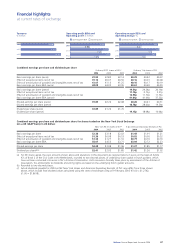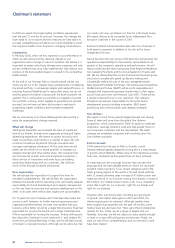Unilever 2004 Annual Report Download - page 20
Download and view the complete annual report
Please find page 20 of the 2004 Unilever annual report below. You can navigate through the pages in the report by either clicking on the pages listed below, or by using the keyword search tool below to find specific information within the annual report.
Unilever Annual Report and Accounts 2004 17
Financial review
Basis of reporting and discussion
Our accounting policies are based on United Kingdom generally
accepted accounting principles (GAAP) and UK and Netherlands
law. These differ in certain respects from United States GAAP. The
principal differences are described on pages 155 to 159. We have
shown reconciliations to net income and capital and reserves
under US GAAP on pages 154 and 155.
For definitions of key ratios referred to in this review please refer
to page 149.
Reporting currency and exchange rates
Foreign currency amounts for results and cash flows are
translated from underlying local currencies into euros using
annual average exchange rates; balance sheet amounts are
translated at year-end rates except for the ordinary capital of the
two parent companies. These are translated at the rate prescribed
by the Equalisation Agreement of £1 = Fl. 12, and thence to
euros at the official rate of €1.00 = Fl. 2.20371 (see Corporate
Governance on page 52).
The figures quoted in the following discussion on pages 17 to 23
are in euros, at current rates of exchange, ie the average or
year-end rates of each period, unless otherwise stated.
Critical accounting policies
The accounts comply in all material respects with UK GAAP and
UK and Netherlands law. To prepare the accounts, we are
required to make estimates and assumptions, using judgement
based on available information, including historical experience.
These estimates and assumptions are reasonable and are re-
evaluated on an ongoing basis. However, actual amounts and
results could differ. Critical accounting policies are those which
are most important to the portrayal of Unilever’s financial position
and results of operations, and are described on pages 96 to 98.
Unilever complies with UK Financial Reporting Standard 18,
which requires that the most appropriate accounting policies
are selected in all circumstances. Some of these policies require
difficult, subjective or complex judgements from management,
the most important being:
Retirement benefits
We account for pensions and similar obligations in accordance
with United Kingdom Financial Reporting Standard 17 ’Retirement
Benefits’ (FRS 17). Under this standard the liabilities and assets of
the plans are recognised at fair values in the balance sheet.
Pension accounting requires certain assumptions to be made in
order to value our obligations and to determine the charges to be
made to the profit and loss account. These figures are particularly
sensitive to assumptions for discount rates, inflation rates and
expected long-term rates of return on assets. The table below sets
out these assumptions, as at 31 December 2004, in respect of the
four largest Unilever pension funds. Details of all assumptions
made are given on page 123.
%%%%
Nether- United
UK lands States Germany
Discount rate 5.3 4.5 5.7 4.5
Inflation assumption 2.8 1.8 2.5 1.8
Expected long-term rate of return:
Equities 8.0 7.6 8.2 7.6
Bonds 5.0 4.1 4.6 4.1
Others 6.8 5.9 4.5 5.5
As required by FRS 17 these assumptions are set by reference to
market conditions at each year end. Actual experience may differ
from the assumptions made. The effects of such differences are
recognised through the statement of total recognised gains and
losses.
Share-based compensation
In line with recommendations of various standard setting bodies,
from 1 January 2003 we changed our accounting policy for share
options. We hedge our existing share option programmes by
buying shares at the time of grant and taking the financing cost
within interest. The accounting change was to include an
additional non-cash charge against operating profit to reflect the
fair value to the employee of the share options granted. The
impact of the adoption of this change was reflected by means of
prior period adjustments to the profit and loss accounts and
balance sheets. In determining the additional charge, we apply a
valuation based on modified Black-Scholes or multinomial models
spread over the vesting period of the option. The fair value so
calculated depends on certain assumptions which are described in
note 30 on page 138. The assumptions made in respect of share
price volatility and expected dividend yields are particularly
subjective. Unilever considers these and all other assumptions to
be appropriate, but significant changes in assumptions could
materially affect the charge recorded.
Provisions
Provision is made, among other reasons, for environmental and
legal matters and for employee termination costs where a legal or
constructive obligation exists at the balance sheet date and a
reasonable estimate can be made of the likely outcome.
Market development costs
Expenditure on market development costs, such as consumer
promotions and trade advertising, is charged against profit in the
year in which it is incurred. At each balance sheet date, we are
required to estimate the part of expenditure incurred but not yet
invoiced based on our knowledge of customer, consumer and
promotional activity.
Goodwill, intangible and tangible fixed assets
Impairment reviews in respect of goodwill and intangible fixed
assets are performed at least annually. More regular reviews, and
impairment reviews in respect of tangible fixed assets, are
performed if events indicate that this is necessary. Examples of
such triggering events would include a significant planned
restructuring, a major change in market conditions or technology,
expectations of future operating losses or negative cash flows.
























